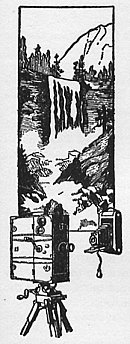We're committed to helping you
Photography in Yosemite National Park (1921)
Photography in Yosemite National Park
Handbook of Yosemite National Park (1921)
by Arthur C. Pillsbury
PHOTOGRAPHY IN YOSEMITE NATIONAL PARK
By Arthur C. Pillsbury, Yosemite California
No souvenir of a vacation can compare with one’s pictures. They are more than mere records of the scenery; each has its own associations, and each brings back memories outside the photo itself. We should strive, however, to produce photographs which have an intrinsic worth as pictures—likenesses which express our own impressions to others. In Yosemite Valley attractive views disclose themselves to every side and even the amateur will have no trouble in securing beautiful pictures if he but give a little thought to composition and correct exposures.
Few people realize what an important part light and shade play in the composition of photographs. Under the high noonday sun most pictures are "flat" and lifeless, and it is during the morning and afternoon hours that the photographer gets his best exposures. The Yosemite features change rapidly in this respect from hour to hour during the day, and the following suggestions are offered with the hope that they will help to solve some of the visitor’s problems.
From within the Valley itself the surrounding mountains and cliffs appear high and near—consequently you would better point the camera up to take their tops. Do not be afraid of distorting them as you would a tall building if you did the same thing, for in Nature there are no parallel lines so marked as to offend in a picture
As to lighting, one should remember that no matter how beautiful a subject is at a given time, it is most beautiful at some certain hours during the day. Yosemite Falls is a good example. At nine o'clock the sun is casting shadows across its cliffs, and the Falls are very beautiful, but the foreground is more or less in the shadow. By ten the sun is on the foreground and full on the cliffs, but the light is a little "flat" and stays so until about one or half past. After this time the Falls are casting their shadows, and every rocket as it shoots out casts its shadow, so they seem to stand out clear cut from the wall. This latter effect increases until two or half past, when the lower half of the Lower Fall is in the shadow. These light and shade effects, in the writer’s opinion, make the best picture. After two thirty the change is very rapid and by three o'clock the Falls are almost entirely shaded.
Bridalveil Falls are in the shadow all the morning hours, so close views are not good until one o'clock when the upper half of the Falls is touched by sunshine and veiled by wonderfully luminous mist. This, their best time and condition for posing, continues until two thirty.
El Capitan from "River View" has several lighting effects that are pleasing. From seven to eight in the morning the shadow cast by the granite wall makes a bold picture which is particularly good in enlargements. During the late morning hours the sun beats down on its smooth face without shadows until one o'clock, when the profile begins to stand out, and ridges, quite unnoticed half an hour before, begin to assume shape and substance; these, the best effects, are of short duration.
At Happy Isles, the Meeting of the Waters, the best time for photographs is from ten to twelve o'clock. Going on up the trail one will find a triangle of sunshine on the lovely Vernal Falls at ten, which continues to light their wonderful outpouring of jewels and color until about eleven; later they are apt to be but a broad white streak in one’s picture.
Nevada Falls seems a thing of life between eleven and twelve thirty when its great rockets cast shadows upon the face of the Fall, but when fully lit by the sun it does not picture as well.
Mirror Lake is at its best until, at about eight o'clock, its surface is struck by the sun, and it loses its reflective power. After this time it is disappointing unless the sky holds floating clouds which produce the most beautiful effect of all.
The foregoing remarks are but a few of the many which might be included if space permitted. The writer will be pleased to make further such suggestions to those who will see him personally in Yosemite.
A word about the time of one’s exposures. Compared with the smoke-laden atmosphere of cities, the light in Yosemite is much faster and clearer, giving strong negatives and good prints and enlargements. The normal exposure within the Valley should be 1/25 second at U. S. stop 8. Mirror Lake before sunrise requires about 1/5 second exposure at U. S. aperture 8, and pictures taken beneath the Big Trees should be given about 1/2 second with the same opening.
At higher altitudes the atmosphere becomes thinner, with the effect that the sky appears more intensely blue but at the same time becomes darker, the sun’s rays become brighter and hotter, and the shadows become deeper and colder. As we ascend we get less diffused illumination from the atmosphere itself, and less protection from the direct rays of the sun. We will therefore get more contract in our negatives which are exposed at the higher elevations, and on account of the more intense light the camera should be stopped down to 16 for 1/25 second exposure.
Distant views require only half as much exposure as near-by subjects. Instead of reducing the exposure the better plan is to diminish the opening so as to admit less light.
If the above suggestions are borne in mind the amateur will find no difficulty in obtaining really good pictures during hs Yosemite vacation.

